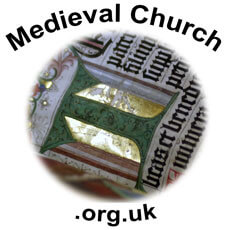Hugh of St. Victor (d.1142)
Theology on the Web helps over 2.5 million people every year to find high quality theological resources that will help to equip them to serve God and to know Him better (2 Timothy 2:15). Like other websites that provide free services, it is dependent on donations to enable it to grow and develop and only 0.004% of visitors currently do so. If you would like to support this site, please use one of the options to the right of this message.
Synopsis
HUGO OF ST. VICTOR, with his contemporaries Abelard amid Bernard, one of the most influential theologians of the twelfth century; was b about 1097; d. Feb. 11, 1141. He gave himself up to a contemplative conventual life, and shone in consequence of piety amid speculative thought, rather than of active participation in the ecclesiastical affairs of his day. He must be regarded as the real founder of the mediæval mysticism of France, for Bernard of Clairvaux is dependent upon him for the essential features of his mystical speculations. The same may be affirmed of Peter Lombard. After-generations gave him the title of Didascalus ("teacher"), or Alter Augustinus ("the second Augustine"). Two localities claim the honor of being if Hugo’s birthplace, - the vicinage of Ypres in Flanders, and Saxony. The Benedictines, in vol. xii. of the Hist. litér. de la France, bring forward three testimonies from old authors in favor of the former. But there are weightier testimonies for Saxony. His tombstone declared Hugo to be of Saxon birth (origine Saxo). This view easily explains his attendance upon the cloistral school of Hamersieben in 1115. To these must be added the testimonies of early Saxon writers who speak of Hugo as belonging to the families of Von Blankenburg and Regenstein in the Hartz Mountains. After passing through the school at Hamersleben, he went with his uncle, archdeacon Hugo of Halberstadt, to France, and entered the famous cloistral institution of St. Victor, near Paris. Fifteen years afterward he was made preceptor of the school, - a position which he continued to fill for eight years. Among his scholars were the afterwards celebrated Adam and Richard of St. Victor. Hugo stood in intimate relations with Bernard, but took no prominent part in the public affairs of Church and State. He was of delicate and sickly constitution.
Hugo’s writings are quite numerous. Those of a more mystical tendency belong to his earlier period. Among these are the three tracts, - De Arca Morali, De Arca Mystica, and De Vanilale Mundi, - in which he compares Noah’s ark with the church, the soul in this world with the soul at peace with God, etc. His exegetical works are confined to no single period of his life. They have only a homiletical interest, and are the least original of his writings. They include a short Introduction to the Scriptures, Commentaries on the Pentateuch, and the other historical books of the Old Testament, on the Psalms and Lamentations, and nineteen Homilies on Ecciesiastes. The other commentaries ascribed to him (Luke, John, etc.) are of very doubtful authenticity. To the last period of Hugo’s life belong his three most valuable works. The Eruditio Didascalia is encyclopedic, and treats in three books of the natural sciences, and in an equal number gives a sort of introduction to church history and the Scriptures. Leaning upon the authority of Jerome, he distinguishes in this second section sharply between the canon and the Apocrypha, but nevertheless seems to give to the writings of the church fathers an equal authority with the canonical books.
The other two works of the last period (the Summa Senlentiarum and the De Sacramentis Christ. Fidei) give the outline of Hugo’s theological views. In the latter he defines his relation to Abelard, to whom, and Anselm, he is under obligations for some of his speculations. The works of God he treats under Works of creation, and Works of’ Restoration. He discusses the Trinity and the three fundamental divine attributes, - power, wisdom, and love. In the treatment of the origin of evil, he is far from the superfluous subtleties of the scholastics of a later period. Original sin he agrees, with Melanchthon, to consist in ignorance and concupiscence. He mentions five sacraments, - baptism, the Eucharist, confirmation, extreme unction, and marriage. They confer grace. In the three sections on eschatology he commends prayers to the saints.
Zöckler, "Hugo of St Victor," Philip Schaff, ed., A Religious Encyclopaedia or Dictionary of Biblical, Historical, Doctrinal, and Practical Theology, 3rd edn, Vol. 2. Toronto, New York & London: Funk & Wagnalls Company, 1894. pp.1030-1031.
Primary Sources
Secondary Sources
| Roger Bacon, Hugh of St. Victor. University of Notre Dame Press, 1966. Hbk. ISBN: 0268001219. | |
| Michael T. Girolimon, "Hugh of St. Victor's De sacramentis Christianae fidei: The Sacraments of Salvation," Journal of Religious History 18.2 (1994): 127-138. | |
| Rebecca Moore, "Hugh of St Victor and the Authorship of Threnos Ieremiae," Journal of Religious History 22.3 (1998): 255-269. | |
| Ray C. Petry, "Three Medieval Chronicles: Monastic Historiography and Biblical Eschatology in Hugh of St. Victor, Otto of Freising, and Ordericus Vitalis," Church History 34 (1965): 282-293. | |
| Dominique Poirel, "Love of God, Human Love: Hugh of St Victor and the Sacrament of Marriage," Communio: International Catholic Review 24.1 (1997): 99-109. | |
| Grover A. Zinn, "Hugh of St. Victor and the Ark of Noah: A New Look," Church History 40.3 (1971): 261-272. | |
| Grover A. Zinn, 'Mandala Symbolism and Use in the Mysaticism of Hugh of St.Victor," History of Religions 12 (1972-3): 317-41. | |
| Grover A. Zinn, "Mandala Symbolism and Use in the Mysticism of Hugh of St. Victor," History of Religions 12.4 (1973): 317-341. |
Related Subjects
 |
|
 |
|
 |





 Hugh of St. Victor, The Didascalicon of
Hugh of St Victor. A Medival Guide to the Arts, Jerome Taylor, translator,
new edn. Columbia University Press, 1991. Pbk. ISBN: 0231096305. pp.254.
Hugh of St. Victor, The Didascalicon of
Hugh of St Victor. A Medival Guide to the Arts, Jerome Taylor, translator,
new edn. Columbia University Press, 1991. Pbk. ISBN: 0231096305. pp.254.


